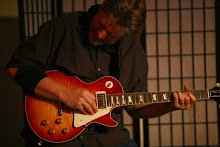theillchef 6/8/2004 12:12 PM
Hey Don, your materials have helped me grow immensely as a player over the past couple of years. All of your books are great but I have one request that I think you could probably do better than anyone else, especially since I haven’t found anything of this type yet. As you’ve mentioned, I know you are a little hesitant with teaching patterns but at the same time realizing that they are indeed helpful for learning the art of improvisation. I agree, and I have stayed away from patterns for the most part in order to secure a more organic sound but I have noticed as of late that they are really helping me out in the sense that new patterns foster new fingerings that I would never had thought of. With that, I would like to suggest a book on advanced digital patterns (or sequencing). I’m sure you have heard that term before, a set of notes played digitally across the neck. Of course digital patterns still have to be made up as far as fingerings go, but each exercise would not stray from the original sequence, unless you delved into key changes via patterns. I hope I am explaining this OK. In fact, your books already have sequencing but they aren’t the large proportion of the material. For example, there is an advanced one called “tricks” I believe in the last section of the Target Tones book. I would pay $100 for a book containing multiple types of these. In short, I have been searching for a book like this for a long time to no avail and figured I’d give it a try. I make my own on occasion but digital patterns are based on phrasing as well as numbers and learning phrases that you wouldn’t have thought of is the main idea here. If each phrase is moved digitally for about 8 bars I believe it would make for great learning material. Different scales (Major, Minor, Melodic Minor, Chromatic, etc.) and different groupings (anywhere from 4 to 12 notes) could be used throughout the book for a versatile lesson base. I could even send samples if I am not clear enough. Also, if you are willing to do this on an individual basses I could funnel those C-notes right to your pocket, and I would be a happy camper at that. Below is my email. Thanks, Art theillchef@aol.com
Don Mock 6/8/2004 7:39 PM
Art, sorry it took me so long to get to your really great post. Sequences are a great way to build technique and help players develop melodic ideas too. I've always stuck some sequences in books but never an entire book on the subject. My old "Hot Licks" book has the most on sequences, probably more than most players would need. Certainly no mystery to making them up. Just mathematical sequences. I used to come up with the math idea first, then record the line at a slow speed on a recorder, (cause I had not practiced it yet) and then play it back speeded up to hear what it would sound like. If I liked it, I would go ahead and learn it and get it down. Lots of them did not sound so great. Just fast predictable licks.I would rather write a book on the process of coming up with sequences than a bunch of them. It sounds like you already know the way sequences are constructed, so you should get to work coming up with the ones you like. And pick only a few that you like and use them. Don't try to tackle too many like I did Just remember. Sequences alone are not the answer to good improvising. They are only one of many tools. If you only play them, your solos will be pretty one-dimensional.And be sure to mix sequences with other types of melodies and don't forget about rhythmic variations and phrasing. But Art, cause you wrote such a good post, here's a sequence that works in any scale. But I mainly use it for a major scale. I'll use numbers to represent the scale tones (1= root etc. all the way into the next octave 1-13)1-5-6-10-9-8-7-6 2-6-7-11-10-9-8-7 3-7-8-12-11-10-9-8 and so on up the scale. It's actually arps in 5th followed by a descending portion of the scale. Check it out.-Don Mock
Subscribe to:
Post Comments (Atom)

No comments:
Post a Comment